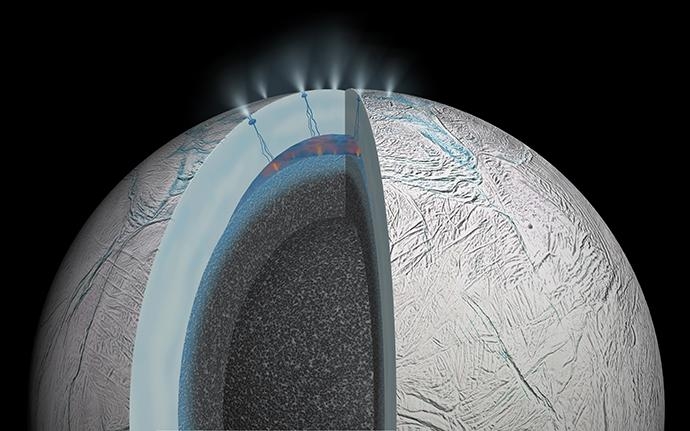An unknown methane-producing process is likely at work in the hidden ocean beneath the icy shell of Saturn's moon Enceladus, suggests a new study published in Nature Astronomy by scientists at the University of Arizona and Paris Sciences&Lettres University.
Giant water plumes erupting from Enceladus have long fascinated scientists and the public, inspiring research and speculation about the vast ocean that is believed to be sandwiched between the moon's rocky core and its icy shell.
Flying through the plumes and sampling their chemical makeup, the Cassini spacecraft detected a relatively high concentration of certain molecules associated with hydrothermal vents on the bottom of Earth's oceans, specifically dihydrogen, methane and carbon dioxide. The amount of methane found in the plumes was a surprise - because it can't be explained by known geochemical processes.
That means an unknown methane-producing process is likely at work in the hidden ocean. Which could have implications for life there, such as microbes - methanogens - that 'eat' dihydrogen and produce methane.
To try and get some insight, a team constructed mathematical models to try and explain what Cassini detected - including the possibility of biological methanogenesis.
They conclude that Cassini's data are consistent either with microbial hydrothermal vent activity, or with processes that don't involve life forms but are different from the ones known to occur on Earth.
 Graphical representation of a cutaway view of Saturn's moon Enceladus that depicts possible hydrothermal activity that may be taking place on and under the seafloor of the moon's subsurface ocean, based on results from NASA's Cassini mission. NASA/JPL-Caltech
Graphical representation of a cutaway view of Saturn's moon Enceladus that depicts possible hydrothermal activity that may be taking place on and under the seafloor of the moon's subsurface ocean, based on results from NASA's Cassini mission. NASA/JPL-Caltech On Earth, hydrothermal activity occurs when cold seawater seeps into the ocean floor, circulates through the underlying rock and passes close by a heat source, such as a magma chamber, before spewing out into the water again through hydrothermal vents. On Earth, methane can be produced through hydrothermal activity, but at a slow rate. Most of the production is due to microorganisms that harness the chemical disequilibrium of hydrothermally produced dihydrogen as a source of energy, and produce methane from carbon dioxide in a process called methanogenesis.
The team looked at Enceladus' plume composition as the end result of several chemical and physical processes taking place in the moon's interior.
First, the researchers assessed what hydrothermal production of dihydrogen would best fit Cassini's observations, and whether this production could provide enough "food" to sustain a population of Earthlike hydrogenotrophic methanogens. To do that, they developed a model for the population dynamics of a hypothetical hydrogenotrophic methanogen, whose thermal and energetic niche was modeled after known strains from Earth.
The authors then ran the model to see whether a given set of chemical conditions, such as the dihydrogen concentration in the hydrothermal fluid, and temperature would provide a suitable environment for these microbes to grow. They also looked at what effect a hypothetical microbe population would have on its environment – for example, on the escape rates of dihydrogen and methane in the plume.
The results suggest that even the highest possible estimate of abiotic methane production – or methane production without biological aid – based on known hydrothermal chemistry is far from sufficient to explain the methane concentration measured in the plumes. Adding biological methanogenesis to the mix, however, could produce enough methane to match Cassini's observations.





Comments